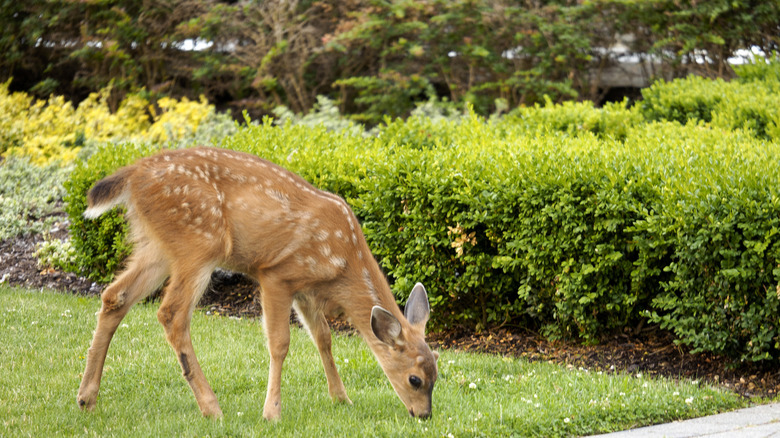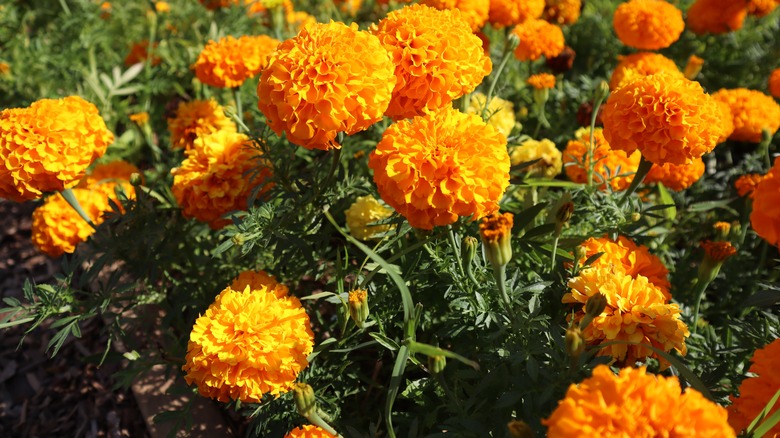How To Stop Deer From Snacking On Your Lilies
Lilies (Lilium) have a lot of admirers, albeit for different reasons. While you might adore them for their colorful blooms, deer appreciate them for their taste. Unfortunately, deer exhibit their appreciation by gobbling down the whole plant, leaving only a hoof print behind as evidence. If the food's plentiful, they stick to sweet nectar and vibrant petals without caring for other plant parts. However, there are no takers for this mercy, as many homeowners prefer erecting 8-foot-high fences to keep deer out of their yards. But they're unattractive (unless you drape vines over them) and expensive, especially in small gardens. So, what's the way out? Deer micro-exclosures.
Built using cattle panels, micro-exclosures are small fences placed around the rows of lilies. They leverage the deer's fear of small places, as they believe they won't be able to escape since they lack sufficient maneuvering room. To make one of your own, set four 16-foot-long cattle panels in the ground and connect them with ⅜-inch-wide cable clamps—use three for each corner. Leave one corner separate; it'll function as the exclosure's gate. Wrap the panels with wire almost 50 feet above ground level. This arrangement should last a decade, but keep an eye out for breaches. If deer venture inside, add a panel in the center to reduce the exclosure size.
Deer repellents for the win
If you're still on the fence about investing in physical barriers and would rather look for more economical options, deer repellents are the way to go. Repellents rely on taste or odor to make the lilies unpalatable to deer, but they aren't foolhardy. In the best circumstances, they decrease deer decimation by around 50% to 70%. You can keep deer out using a soap bar; just scatter its shavings around the flowers. Follow the same rule for spreading human hair or pet feces. They deter the four-footed animals because they remind them of predatory threats. Products smelling like coyote urine or blood have shown great results when applied in dry conditions, but they'll leave you feeling squeamish.
Another excellent repellent is rotting egg solids (the smell, ugh!). You can even DIY your egg repellent by blending three eggs in water and pouring the solution into a 1-gallon container. Add water to the brim and strain the mix. Decant the liquid in a spray bottle and spritz it until the foliage is dripping wet. Replenish the deterrent every other week or when it rains. Remember, it only works during the summer when deer can smell it and won't save your overwintering lilies. Also, it's futile against an assuredly ravenous deer. That being said, all repellents work best before deer take to your garden, so start applying at the first sign of damage.
Modify the landscape
When repellents fail to lead the deer out with their noses (make sure you've tried out a couple), it's best to modify the habitat. Despite their penchant for sampling everything falling in their line of sight, deer have a list of plants whose taste, odor, and texture feel unpleasant — hairy and spiny varieties are a no-no, too. The downside is the list varies as deer develop different eating habits depending on the region. Moreover, some plants experience seasonal deer resistance. However, interplanting marigolds, poppies, asters, and lavender shrubs should bring some respite — all of which grow as companions alongside lilies. It's best to check in with your local extension for the best options.
While noise-making devices, such as exploders and whistles, have shown positive results in discouraging deer activity, they eventually become habitual to them, making them unconducive for the long term. In contrast, motion sensor sprinklers have worked better as they follow up their movement (and noise) with water splash, scaring deer away. Finally, consider letting out your pet dogs to alleviate deer problems.


